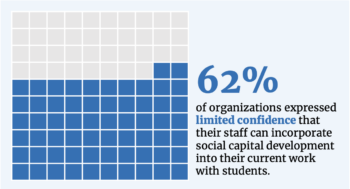Social Capital and Me: A Mid-Career Change Underscores the Value (and Need!) for Social Capital Development

I grew up as a military brat, moving around and bouncing across continents, countries, states, and their local K-12 school systems. This gave me a unique vantage point into, and across, education systems. Incredibly, many systems—domestic and foreign—seemed to produce disparities that felt unfair, unnecessary, and frustratingly pervasive.
My fascination (and frankly, indignation) with these observations led me to the classroom. I felt assured in my decision to become a teacher, and relieved that the hiring process was fairly easy. And when I decided that I wanted to tackle education on a bigger scale and transition to education policy, that was a fairly seamless process for me as well (thank goodness!).
Eventually, I began to feel that my job did not allow me to use my skills effectively to combat those persistent educational inequities – the whole reason I got into education in the first place! So, I decided to explore my options. I knew I wanted to work for a mission-driven organization that was tackling these issues. At this point, I had only worked in the classroom and in state government, so the national education organization landscape felt foreign and intimidating. Making a pivot to this new world was not as easy as my earlier career moves, but what largely helped me succeed was learning to build my social capital network.
“Throughout my education and career journey, I had made connections with people; but when I was looking for a new job that would better align with my values, I had no idea how to begin engaging my network – or how to build upon it – to further my career goals.”
There was no “how-to” on social capital that I received in school. I was virtually at step zero. I did not have a LinkedIn page. I did not know that informational interviews were a thing. I did not know the mechanics of social capital. I understood that who you knew mattered, but how do you get to know new people who can help you get to where you want to go? And why was this process so mysterious!?
I started by reaching out to former colleagues who offered career advice, which helped me strategize for a job transition. Those colleagues helped me make new connections with people working in the education space to see what my options were outside of the public sector. I contacted a former professor who I had not spoken with in over a decade, but was kind enough to provide encouragement and help me make connections locally. I reached out to literal strangers who worked at organizations I was interested in (which I now know is normal, but at the time seemed nuts). Eventually, mobilizing my social capital network did help me to land this job at ESG, and I could not be more grateful. BUT, it should not have taken a mid-career transition to help me to realize my social capital.
But of course this is what we mean when we talk about the imperative to embed social capital development into student experiences. Yes, students need a clear vision for their career and the right skills, experience, and qualifications; but that’s not always enough. It’s no secret that most successful job seekers leverage their networks to secure a job, and yet we don’t teach students how to do it. I certainly didn’t learn it in school (and unlike our wonderful summer intern, Janeva Wilson, I didn’t learn it at home either). But as it turns out, my experience is pretty common.
Earlier this year, ESG completed a multi-methods landscape scan to better understand where the field – including state education agencies, school districts, and national and regional intermediaries — currently is in their efforts to develop students’ social capital building skills. One encouraging finding was that organizations of all types overwhelmingly agreed that social capital was important for helping students build their professional skills and prepare for postsecondary education, and is an essential component as they embark on their own career journey. They get it – social capital is important! – and yet, this question remained: were they helping the students they work with understand this process?
We found a disconnect between the desire to incorporate social capital into college and career pathways work and a concrete approach to doing so. Even defining social capital is sticky, squishy business. Organizations we surveyed used inconsistent language to describe social capital efforts, which speaks to how new this concept is within the field of education. Nearly half of the state agencies or intermediaries we surveyed reported that social capital was “minimally established” in their organizations, demonstrating that this very important concept has not worked its way into their processes and established pathways efforts. Furthermore, many organizations (collectively, 62%) expressed limited confidence that their staff can incorporate social capital development into their current work with students.

When you look a little closer at our data, it’s clear that statewide agencies or intermediaries and districts and regional intermediaries are even less confident with their social capital development capabilities than national organizations, with nearly 75% and 60% respectively indicating that they are only somewhat confident with this work. Turns out, it’s not just a mystery to me!
In order to help students learn how to build their social capital, there needs to be some capacity building in the field that gets more to the how-to of it all. We know that making connections is vitally important to helping students find a job in the future, especially those who are first-generation college students. But there needs to be a reimagining of the education system that prioritizes student social capital development and provides the necessary time, explicit instruction, and resources to empower educators to serve as brokers of student network growth.
Social capital does not start or end with connecting students to a worksite supervisor, career coach, or mentor. Education leaders must keep in mind the need for students to gain concrete skills that they can use for their life. We must help students build the skills to make connections on their own and know that they can reach out to their current network or, if need be, expand their network to get to where they want to go (after all, they too may make a mid-career pivot one day!).
The good news is organizations are hungry for resources to help them do just that. 92% of survey respondents, regardless of where they were in their social capital journey, reported that it would be helpful to receive additional resources and assistance to further their progress in helping students build their social capital skills.
Cultivating Connections—a resource developed by ESG—offers a framework for how communities can approach this work developed through two years of work with ten local teams across the U.S. looking to integrate social capital into their college and career pathways. As ESG continues its social capital work, we are committed to helping more communities further their understanding of social capital and developing the tools needed to help practitioners help students develop the concrete skills needed to harness the power of social capital to get their dream job. After all, it doesn’t have to be quite so mysterious.
If you are interested in helping your students build their social capital skills, visit Cultivating Connections and email Tina Young if you would like to learn more.



